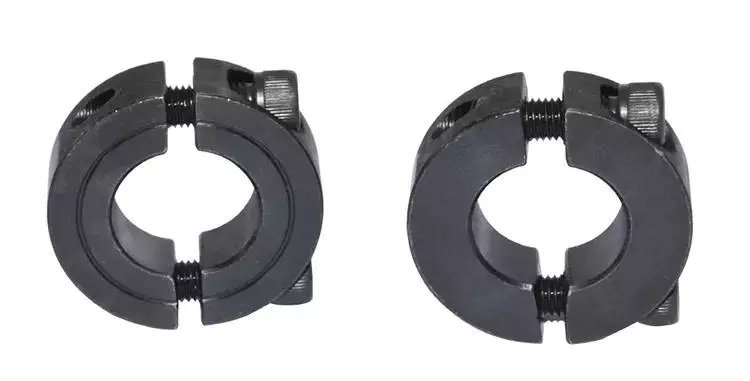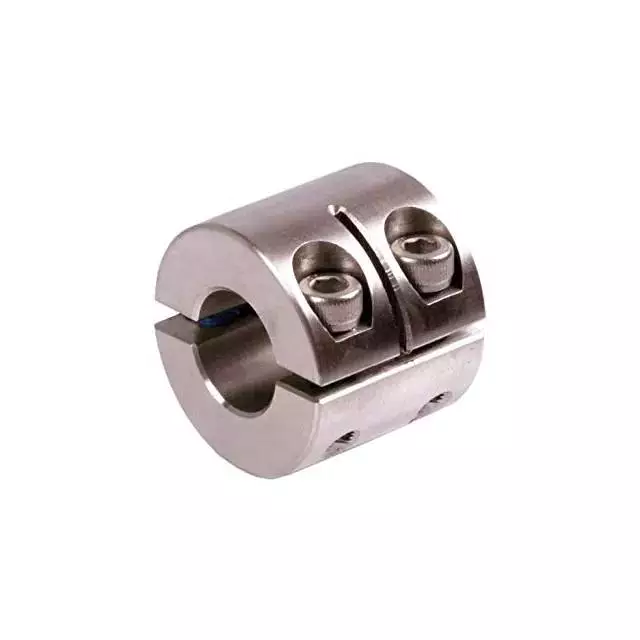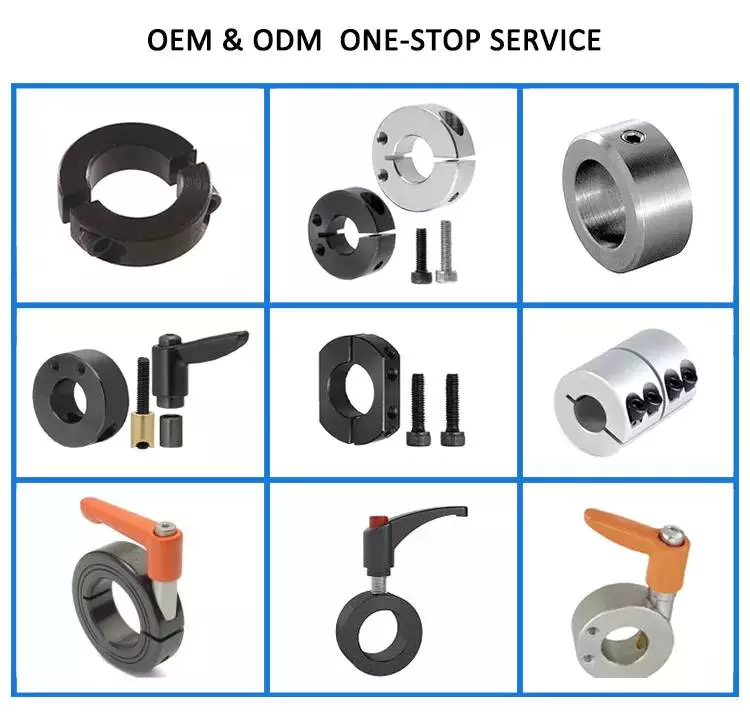Product Description
CZPT Keyless Locking Devices are used in rotating machinery, producing clamping pressure between surface of locking device and shaft to create adjustable and releasable mechanical connection, so as to clamp gears, pulleys and other components to a shaft without threads or keys.
Raw materials available in:
l Steel C45E,
l Steel 42CrMo4V
l Stainless Steel AISI431,
l Stainless Steel AISI304
Features:
1. Connect hubs solidly to shafts
2. Easy installation and disassembly
3. High torque transmission
4. Long lifetime and easy maintenance
5. Low notching effect
6. Reduction of wear and tear of expensive machine components
Ubet Machinery provides types of Keyless Locking Devices, which are interchangeable with many European and American brands. High quality always comes the first.
Ubet Keyless Locking Device KLD-1 Medium torque, not self-centering, Medium surface pressures, No axial hub movement, flexible use, machining tolerance shaft H8, hub H8; socket head locking screw DIN912-12.9. The most popular type of all KLD Locking Device, CZPT Connection; the slotted design of the double tapered rings enables relatively high mounting tolerance, The large taper angles are not self-locking and facilitate the release of the connection.
KLD-1 Interchange with Z2,BIKON 4000,BEA BK40,BONFIX CCE2000,Challenge 01,Chiaravalli RCK40,CONEX A, Fenlock FLK200,ITALBLOCK CN210,KTR100,KINLOK LOK30,KBS40,KANA 200,MAV 2005,POGGI CAL-A,RFN7012,Ringspann RLK200,Ringblok 1120,SIT 1,SATI KLGG,TOLLOK TLK200,Tsubaki AS,TAS3571,V-Blok VK400,Walther CZPT MLC 1000,Fenner Drive B-Loc B400,LoveJoy SLD1500, FX10,OKBS40,DRIVELOCK40
Ubet Keyless Locking Assembly KLD-2 Medium torque, self-centering, small cross section, machining tolerance shaft H8, hub H8; Socket head locking screw DIN912-12.9
Self-centering with excellent concentricity; the small outer diameter is space-saving and suitable for small wheel diameters; the spacer ring between the outer flange and the hub maintains the fitting position in the axial direction to enable exact positioning without a shaft collar; the push-off threads in the outer flanges are used for dismantling.
KLD-2 Interchange with Z11,BIKON 8000,BEA BK80,BONFIX CCE1000,Challenge 02,Chiaravalli RCK80,CONEX B,7110 ECOLOC, Fenlock FLK110,GERWAH PSV2571.1,ITALBLOCK CN55,KTR250,KINLOK LOK10,KBS80,MAV 5061,POGGI CAL-B,RFN7110,Ringspann RLK110,Ringblok 1100,SIT 3,SATI KLCC,TOLLOK TLK110,Tsubaki TF,V-Blok VB800B,Walther CZPT MLC3000,Fenner Drive B-Loc B800,LoveJoy SLD1900, FX20,OKBS80,DRIVELOCK80
Ubet Locking Elements KLD-3
Low torque, Medium surface pressure, Taper rings only, Low axial and radial dimensions
This clamping set is self-centering with excellent concentricity. The extremely small outer diameter is space-saving and suitable for small wheel diameters. The spacer ring between the outer flange and the hub maintains the fitting position in the axial direction to enable exact positioning without a shaft collar. The push-off threads in the outer flanges are used for dismantling.
KLD-3 Interchange with Z1,BIKON 5000,BEA BK50,BONFIX CCE3000,Challenge 03 Chiaravalli RCK50,CONEX C,Fenlock FLK300,ITALBLOCK CN31,KRT150,KINLOK LOK80,KBS50,KANA 300,MAV 3003,POGGI CAL-C,RFN8006,Ringspann RLK300,Ringblok 1060,SIT 2,SATI KLNN,TOLLOK TLK300,Tsubaki EL, ,Walther CZPT MLC 2000,Fenner Drive B-Loc B112,LoveJoy SLD350, FX30,OKBS50,DRIVELOCK50
Ubet Mechanical Locking Device KLD-4
High torque, self-centering, medium surface pressure, machining tolerance shaft H8, hub H8; socket head Locking screw DIN912-12.9
KLD-4 Interchange with Z3,BIKON 7000A,BEA BK70,BONFIX CCE4000,Challenge 04,Chiaravalli RCK70,CONEX D,7004 ECOLOC, Fenlock FLK130,GERWAH PSV2007,ITALBLOCK CN54/N,KTR200,KINLOK LOK20A,KBS70,MAV 6901,POGGI CAL-D,RFN7013.0,Ringspann RLK130,Ringblok 1300.1,SIT 5A,SATI KLDA,TOLLOK TLK130,V-Blok VK700, FX40,OKBS70,DRIVELOCK70
Ubet Shaft Hub Connection KLD-5
Medium torque, reduced length, medium self-centering, High surface pressure, machining tolerance shaft H8, hub H8; socket head Locking screw DIN912-12.9
Suitable for narrow, disk-shaped wheel hubs. Self-centering and self-locking in the clamping state.
KLD-5 Interchange with Z3B,BIKON 1003,BEA BK13,BONFIX CCE4100,Challenge 05,Chiaravalli RCK13,CONEX DS,7003 ECOLOC, Fenlock FLK132,GERWAH PSV2006,KTR203,KBS13,KANA 201,MAV 1062,POGGI CAL-DS,RFN7013.0, Ringspann RLK132,Ringblok 1710,SIT 6,SATI KLAA,TOLLOK TLK132,TAS3003, V-Blok VK160,Walther CZPT MLC 5006,LoveJoy SLD1750, FX41, OKBS13, DRIVELOCK13.
Ubet Shaft Locking Device KLD-6
Medium torque, self-centering, Low surface pressure, No axial hub movement, machining tolerance shaft H8, hub H8; socket head Locking screw DIN912-12.9
KLD-6 Interchange with Z13,BIKON 7000B,BEA BK71,BONFIX CCE4500,Challenge 06,Chiaravalli RCK71,CONEX E,7007 ECOLOC, Fenlock FLK131,GERWAH PSV2007.3,ITALBLOCK CN54/S,KTR201,KINLOK LOK20B,KBS71,MAV 6902,POGGI CAL-E,RFN7013.1,Ringspann RLK131,Ringblok 1300.2,SIT 5B,SATI KLDB,TOLLOK TLK131,Tsubaki KE,V-Blok VK700.1,Walther CZPT MLC5000B, FX50,OKBS71,DRIVELOCK71
Ubet Clamping Power Lock KLD-7
Medium torque, reduced length, High surface pressure, No axial hub movement, machining tolerance shaft H8, hub H8; socket head Locking screw DIN912-12.9; Simultaneous Connection of Chain Sprocket
KLD-7 Interchange with Z8,BIKON 1006,BEA BK16,BONFIX CCE4600,Challenge 07,Chiaravalli RCK16,CONEX ES,7006 ECOLOC,Fenlock FLK133,GERWAH PSV2006.3,ITALBLOCK CN9/4,KTR206,KBS16,KANA 201,MAV 1061,POGGI CAL-ES,RFN7013.1,Ringspann RLK133,Ringblok 1720,SATI KLAB,TOLLOK TLK133,Tsubaki AE,TAS3006,V-Blok VK130,Walther CZPT MLC 5007,LoveJoy SLD1750, FX51,OKBS16,DRIVELOCK16
Ubet Shrink Disc KLD-14
High torque, No axial hub movement, High speed application, preferred solution for coupling hub and hollow shaft gearbox, DIN931-10.9 screw; Smart-Lock Shrink Disc, Narrow Hub Connection for sprockets, connect hollow and CZPT shafts frictionally and backlash-free.
KLD-14 Interchange with Z7B,BEA BK19,BONFIX CCE8000,Challenge 14,Chiaravalli RCK19,CONEX SD, Fenlock FLK603, ,KTR603,KBS19,MAV 2008,RFN4071,Ringspann RLK603,Ringblok 2200,SATI KLDD,TOLLOK TLK603, Tsubaki SL, ,Walther CZPT MLC 9050,Fenner Drive B-Loc SD10,LoveJoy SLD900, FX190,OKBS19,DRIVELOCK19
Ubet Locking Assembly KLD-15
High torque, self-centering, Low-medium surface pressure, machining tolerance shaft H8, hub H8; socket head Locking screw DIN912-12.9
KLD-15 Interchange with BEA BK15, Challenge 15,Chiaravalli RCK15,CONEX EP, Fenlock FLK134,KBS15 ,MAV 3061,Ringspann RLK134,SATI KLBB,TOLLOK TLK134, FX52,DRIVELOCK15
Ubet Locking Bushes KLD-16
Medium torque, Reduced length, Medium self-centering, High surface pressure, machining tolerance shaft H8, hub H8; socket head Locking screw DIN912-12.9
KLD-16 Interchange with BONFIX CCE4900,Challenge 16,CONEX L,KTR225,KBS52,SATI KLHH, FX120
Ubet Ball Bearing Adapter Sleeve KLD-17
Low torque, Short Length, Not self-centering, Low surface pressure, machining tolerance shaft H8, hub H8
KLD-17 Interchange with BEA BK25, Challenge 17, KBS51, SATI KLFC, FX80
Ubet Bearing Adapter Sleeve KLD-17.1
Low-medium torque, self-centering, low surface pressure, machining tolerance shaft H8, hub H8
KLD-17.1 Interchange with Z19B, BEA BK26,Challenge 21,Chiaravalli RCK55, Fenlock FLK250,KTR125,KBS55, POGGI CAL-L,Ringspann RLK250,Ringblok 1500, SATI KLFF,TOLLOK TLK250
Ubet Shaft Clamping Collar KLD-18
Low-medium torque, Short Length, self-centering, low surface pressure, machining tolerance shaft H8, hub H8, socket head Locking screw DIN912-12.9
This clamping set is self-centering and suitable for extremely small shaft diameters. It transfers average to large torques
KLD-18 Interchange with BEA BK61,Chiaravalli RCK61,7002 ECOLOC ,GERWAH PSV2061,KTR105,KBS61,MAV 7903,SATI KLSS, Walther CZPT MLC 5050, FX350,OKBS61,DRIVELOCK61
Ubet Clamping Device KLD-19
very high torque, self-centering, medium surface pressure, no axial hub movement, machining tolerance shaft H8, hub H8, socket head Locking screw DIN912-12.9
This clamping set is self-centering with excellent concentricity. The extremely small outer diameter is space-saving and suitable for small wheel diameters. The spacer ring between the outer flange and the hub maintains the fitting position in the axial direction to enable exact positioning without a shaft collar.
KLD-19 Interchange with Z12A,BIKON 1012,BEA BK11,BONFIX CCE9500,Challenge 19,Chiaravalli RCK11,CONEX F,7005 ECOLOC,Fenlock FLK400,GERWAH PSV2005,ITALBLOCK CN911,KTR400,KINLOK LOK40,KBS11,MAV 4061,POGGI CAL-F,RFN7015,Ringspann RLK400,Ringblok 1800,SIT 4,SATI KLEE,TOLLOK TLK400,Tsubaki AD,TAS3012,V-Blok VK112,Walther CZPT MLC 4000/MLC 7000,Fenner Drive B-Loc B112,LoveJoy SLD2600, FX60,OKBS11,DRIVELOCK11
Locking Device KLD-33 interchange with Z4, RFN7014
Locking Device KLD-34 interchange with Z5,BIKON 1015.0/1015.1, 7009 ECOLOC,Fenlock ,GERWAH PSV2009, KTR401,MAV 1008,RFN7015.0,Ringspann RLK401,Ringblok 1810,TOLLOK TLK451,TAS3015.0/3015.1,
Keyless Locking Device also call as below
1. Welle-Nabe-Verbindungen;
2. Wellenspannsaetze,
3. Spannsaetze,
4. Taper Spannbuchsen,
5. Taper Lock,
6. Keyless Locking Device,
7. Keyless Locking Assembly,
8. Keyless Shaft Locking Device,
9. Keyless Shaft Hub Locking Device,
10. Keyless Bushings,
11. Keyless Shaft Hub Connection,
12. Clamping Sleeve,
13. Clamping Element,
14. Clamping Collar,
15. Clamping Bush,
16. Clamping Devices,
17. Clamping Set,
18. Clamping Power Lock,
19. Cone Clamping Element,
20. Shaft Clamping,
21. Shaft Fixing,
22. Shaft Fixing Cone Clamping Element,
23. Conical clamping rings,
24. Shaft Lock Clamping Element,
25. Shaft Clamping Element,
26. Shaft Clamping Collar,
27. Shaft Locking Device,
28. Shaft Hub Connection,
29. Shaft Hub Locking Device,
30. Shaft Hub Locking Assembly,
31. Shaft Lock,
32. Silted Clamping Element,
33. Shaftlock Clamping Element,
34. Locking Assembly,
35. Locking Bushes,
36. Locking Rings,
37. Rigid Shaft Coupling,
38. Rigid Shaft Coupler,
39. Rigid Ring Block,
40. Ring Shaft Lock,
41. Ringblock Locking Assemblies,
42. CZPT Connection,
43. Zinc Plated Locking Devices,
44. Nickel Plated Locking Assembly,
45. Mechanical Locking Device,
46. Mechanical shaft lock,
47. Schrumpfscheibe,
48. External Locking Assembly,
49. Narrow Hub Connection for Sprockets,
50. Shrink Disc,
51. Brake Disc,
52. Shrink Disk,
53. External Locking Assembly Light Duty,
54. Shrink Discs Standard Duty,
55. Shrink Disks Heavy Duty,
56. Smart-Lock Schrumpfscheibe,
57. Smart-Lock Shrink Disc,
58. Bearing Adapter Sleeve,
59. Lock Nut,
60. POWER NUT,
61. POWER LINK,
62. Shaft Self-Lock Ring Nut,
63. Nickel Plated Locking Devices,
64. Zinc Plated Locking devices,
65. Stainless Steel Locking Devices.
| Standard or Nonstandard: | Standard |
|---|---|
| Feature: | Cold-Resistant, Corrosion-Resistant, Wear-Resistant, High Temperature-Resistance |
| Application: | Textile Machinery, Garment Machinery, Conveyer Equipment, Packaging Machinery, Motorcycle, Food Machinery, Marine, Mining Equipment, Agricultural Machinery |
| Surface Treatment: | Zinc Plating |
| Material: | Carbon Steel |
| Rfn7015.0: | 100X145 |
| Samples: |
US$ 2.5/Piece
1 Piece(Min.Order) | |
|---|
| Customization: |
Available
| Customized Request |
|---|
Choosing a Shaft Collar
The shaft collar is a simple machine component used in a variety of power transmission applications. They are most often found on gearboxes and motors. Their simple design makes them an easy component to install and remove. Among other uses, shaft collars are used as bearing faces, mechanical stops, and locating components.
Clamp-style shaft collars
Clamp-style shaft collars fix many of the problems associated with set-screw collars. Available in two-piece and one-piece designs, these collars compress the shaft and lock into place. This allows for a uniform distribution of force on the shaft. Clamp-style shaft collars provide more holding power than set-screw collars, but they work best under consistent pressure. Clamp-style shaft collars also work better against negative forces, as they have a separate, un-tightened side.
Clamp-style shaft collars feature mounting holes in the outer diameter. Like clamp-style collars, mountable shaft collars can be installed on adjacent assemblies, but the mounting method does not affect holding power. Mountable shaft collars are commonly used in mounting sensor brackets. They may have rounded or flat outer diameters to accommodate the mounting process. Mountable shaft collars may also have tapped or flat holes to facilitate installation.
Quick-clamp shaft collars have the same functionality as clamp-style collars, but feature a removable lever. They are typically quick-to-install and do not mar the shaft. Quick-clamping collars are especially beneficial in applications that require light-duty torque. They also make for quick and easy adjustments.
Heavy-duty shaft collars feature larger outer diameters, a wider face, and a larger screw. These collars are ideally suited for d-shafting and can offer greater holding power than set-screw collars. These collars are typically manufactured from high-strength 2024 aluminum.
Clamp-style shaft collars can be used in many different applications. They can be used for a variety of applications, including bearings, and are especially suited for rotary machines. However, there are some drawbacks. While they may not be as flexible as set-screw collars, they can still perform well under constant loads. One drawback is that they tend to loosen under shocks and reduce the holding power of clamping hardware.
Another advantage of clamp-style shaft collars is that they do not mar the shaft and allow for easy positioning adjustments. Furthermore, they are easier to install and offer greater holding power than set-screw collars. These collars are made from high-quality materials with tight tolerances and are available in different bore sizes.
Clamp-style shaft collars are the most common type of shaft collars. They can be two-piece or one-piece. Among these, two-piece collars are the most convenient option. One-piece collars are hard to move, and two-piece collars have a hinge on one side and a clamp-style collar on the other side.
The materials used in Clamp-style shaft collars play a crucial role in their overall performance. They should be strong, corrosion-resistant, and have good holding power. They should also be able to withstand high temperatures. The most common materials used for shaft collars are steel and aluminum. Some types are made from stainless steel, while others are made from engineered plastic.
Clamp-style shaft collars can come in two pieces or single-piece designs. The smaller one-piece collars usually have a back-cut opposite the clamp cut, which reduces the cross-sectional area at the hinge point. This reduces the amount of force required to clamp the collar, which makes it easier to use stronger screws.
Aluminum, carbon steel, and stainless steel shaft collars
When choosing a shaft collar, you should consider the material it is made of. You can purchase collars made of carbon steel, aluminum, or stainless steel. Each of these materials has its benefits and disadvantages. Steel is more durable than aluminum and tends to provide better holding power. Aluminum, on the other hand, is lighter and has a favorable strength-to-weight ratio. The material you choose should depend on your specific needs, such as corrosion resistance or weight.
Mountable shaft collars are used to mount sensors, fixtures, and other assemblies. These collars are available with outer diameter holes, flats, or quick-release designs. The material used to make these collars varies, with standard models made of 1215 lead-free steel and 2024 aluminum.
When choosing shaft collars, take into account the material and surface treatment. Different materials offer different properties, which will determine the performance of the collar. In addition to material, each shaft collar comes with a different holding power. Holding power is a key factor in choosing a shaft collar because it determines the amount of load it can withstand without slipping. The holding power depends on the screw size, the bore size, and the bulk of the collar.
Aluminum, carbon steel, and stainless steel shaft-collars can come in various styles. CZPT, for example, offers standard shaft collars in hex and d-bore profiles. Hex collars provide extra holding power and are better than set screws. Additionally, they do not mar the shaft and provide a better grip.
Another type of shaft collar is the quick-clamp shaft collar. These features allow users to install and remove them with ease. The quick-clamp collar has a handle that allows the user to quickly adjust it. While these shaft collars are designed for light duty applications, they are not recommended for heavy-duty or high-RPM applications.
Shaft collars are simple yet versatile components. They are used for various applications, including mechanical stops, stroke limiters, and retainers. They can also be used to align and space other components. Shaft collars are widely used in gearbox assemblies, flagpoles, and medical instruments, among others.
Two-piece shaft collars offer the same benefits of one-piece shaft collars, but offer additional convenience and versatility. They are easier to install and disassemble, reducing installation and labor costs. They also offer superior holding power. They also feature a threaded bore that acts as a positive mechanical stop when the shaft is rotated.
Over-torqueing shaft collars
Shaft collars are often used to secure components on shafts or other surfaces. They also provide an easy way to adjust the positioning of motor assembly components. Many different types of shaft collars are available to meet the specific needs of different applications. These include round, hexagonal, square, and D-bore collars.
The design of shaft collars must account for the load they will support. Some collars are made of metals, while others are made of plastic or composite materials. Typically, shaft collars are made of steel, but can also be made from aluminum or alloyed steel. Some are coated with zinc.
Shaft collars are available in one-piece and two-piece designs. Single-piece collars are designed to fit securely around a shaft, while double-piece collars allow for greater clamping force. These collars can be assembled anywhere along the shaft and can be installed between two pieces. They are available in different bore configurations and can be customized to meet your specific application.
Clamp style collars are easy to install and disassemble, and have a larger holding force than one-piece collars. These collars are also more shock-load resistant. They also don’t mar shaft surfaces, unlike setscrews. They can also be easily adjusted without damaging the shaft. Another style of collar is the quick-clamping style. This type of collar doesn’t mar the shaft, and is easily installed and removed without tools. These are best for light-duty applications.
When choosing a shaft collar, you should consider the tolerance of the shaft. It is important to select a shaft with a tight tolerance. The shaft’s hardness should not be greater than Rockwell C35. A wide tolerance will affect the holding power of the collar. If the shaft is undersized, you may need to use a screwdrive to slide the collar on the shaft.
Shaft collars are a versatile component with many different applications. They can secure industrial railings or serve as positioning devices in medical equipment. They are also widely used in automation machinery. They are used to protect cylinders and actuators and to ensure alignment between components. For this reason, they are very versatile and adaptable.
Clamp-style collars work well under constant loads, but they may need assistance during impact loads. Shock loads can be difficult to avoid, especially if the mass is small. Clamp-style collars with an undercut in the shaft help to resist the impact of shock. Moreover, they offer positive stops in both axial directions.
Clamp-style shaft collars are a good alternative for set-screw collars. They are easy to install and prevent shaft damage. They also come with an added advantage of being easy to adjust. Clamp-style shaft collars have double the holding power of set-screw collars.
In addition to holding components, shaft collars can also function as spacers and limit shaft movement. They are essential for many applications. They are commonly used in motors and gearboxes to ensure correct positioning for power transmission. They are also used to control shaft movement in reciprocating applications.
editor by CX 2023-06-06




